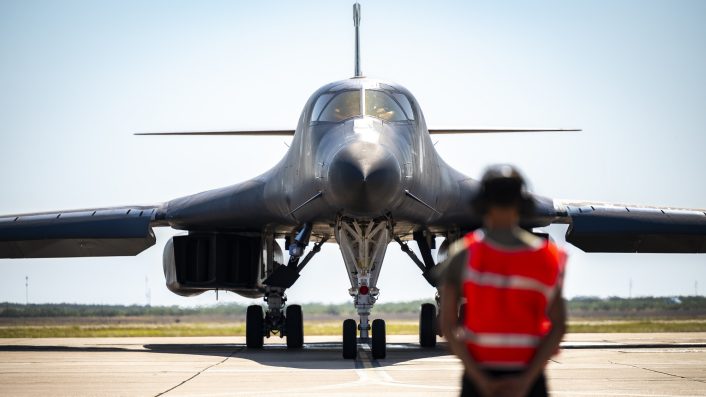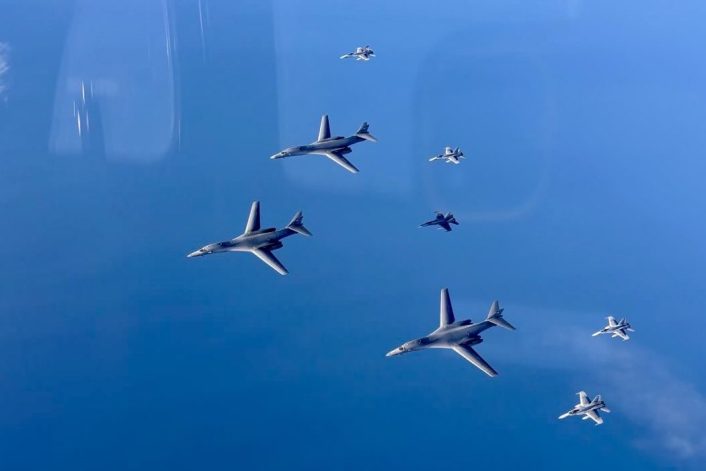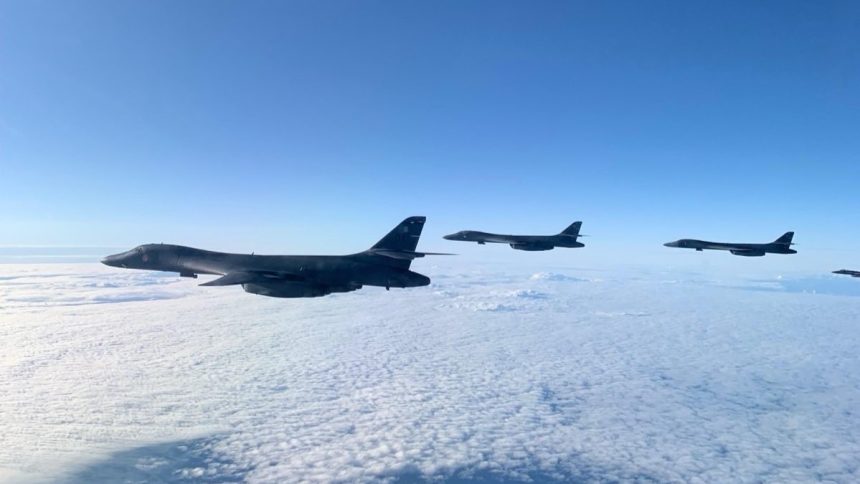The bombers will fly Ally-led missions to practice high-threat air operations and refine skills in the find, fix, track and target process.
Three U.S. Air Force B-1B Lancer bombers arrived in Norway on Aug. 9, 2025, to begin Ally-led training operations as part of the latest Bomber Task Force Europe 25-4B. The aircraft, assigned to the 345th Expeditionary Bomb Squadron from Dyess Air Force Base, Texas, arrived at Ørland Air Base after being escorted by Spanish Air and Space Force EF-18M Hornets operating from Keflavik Air Base, Iceland.
COSMIC11 flt has landed at Ørland Air Base, Norway 💪 😎
📷 FOSNAFOLKET https://t.co/Jfp8EVoiyo pic.twitter.com/D7da1qbQlX
— Thenewarea51 (@thenewarea51) August 9, 2025
Bomber Task Force Europe 25-4B
This is not the first time the BONEs (from B-One – as the B-1s are dubbed by their aircrews) are deployed to Ørland, as they already did in 2021 when they marked the first time U.S. bombers operated out of Norway. According to the Air Force, during the deployment the bombers will practice high-threat air operations and refine skills in the find, fix, track and target process together with Allied assets.
#BTF bombers have arrived in theater, operating alongside Allies & partners to reinforce regional stability and support homeland defense. #BomberTaskForceEurope
Read story here: https://t.co/HfnMA4ZtDS pic.twitter.com/0NX13bsVaC
— USAFE-AFAFRICA (@HQUSAFEAFAF) August 9, 2025
“Aircrews will train on key elements of the find, fix, track and target process – honing the speed and accuracy with which bombers and fighters are able to act against threats in real time,” explains the service. “As aircrews practice these skills, they simultaneously train against ground and air-based threats designed to deny their freedom to maneuver, requiring them to act decisively to counter threats and gain air superiority.”
🇪🇸 Hornets on 🇮🇸 Air Policing escorted 🇺🇸 B-1Bs to 🇳🇴for this iteration of Bomber Task Force in Europe. The BTF will will fly a series of Ally-led missions alongside Norwegian F-35 fighters and other NATO aircraft #WeAreNATO
Learn more: https://t.co/EQqUtaBSmD pic.twitter.com/3SbzdbE3I1
— NATO Air Command (@NATO_AIRCOM) August 11, 2025
While no specific details have been released, this training might build up on previous exercises like the one which saw the participation of B-52H Stratofortress bombers in December 2024. On that occasion, multiple assets, also including F-35 Lightning IIs, a P-8 Poseidon, RC-135 Rivet Joint, a U-2 Dragon Lady, were involved in a multi-domain find, fix, track and target mission in the High North, a region with significant strategic importance.
Sky high unity ✈️🤝
U.S. B1-B Lancers arrived at Ørland Air Base, NOR, to begin training as part of the new Bomber Task Force. This team-up allows crews to refine tactics, enhance flexibility, and strengthen coordination.
Our Allies stay ready to respond at a moment’s notice. 🫡 pic.twitter.com/mnDJN9kxip
— SHAPE – NATO Allied Command Operations (@SHAPE_NATO) August 11, 2025
“This deployment allows us to train the way we fight — integrated with our NATO Allies, ready and adaptive,” said Lt. Col. Eric Alvarez, 345th Bomb Squadron deployed commander. “It’s about building experience and trust together, enhancing readiness, and staying sharp in dynamic environments.”
The press releases highlighted that the bombers will fly missions alongside Norwegian F-35 fighters. Notably, Ørland Air Station is the main operating base of the Royal Norwegian Air Force F-35 fleet.
“It’s about building experience and trust together, enhancing readiness, and staying sharp in dynamic environments.” Norwegian Lieutenant Colonel Tom Christiansen, acting chief of the 132 Air Wing at Ørland, added: “This type of training makes us better equipped to handle any challenges.”

Demand for bombers grows
The U.S. Air Force highlighted that this is the 5th Bomber Task Force Europe deployment in 2025 and reflects the service’s continued commitment to maintaining a ready and capable forward presence across the region. This follows recent comments by Air Force Global Strike Command that demand for bomber capabilities is growing around the globe, with U.S. bomber units stepping up the pace of operations.
“In the last 18 months, I have seen more activity and more demand signals for bombers than I have seen probably in the last, at least, five to 10 years,” AFGSC boss Gen. Thomas Bussiere said to Air & Space Forces Magazine. Bussiere detailed that the service deployed bomber task forces 48 times in that timeframe, and 33 times in 2024 alone, including 10 each in the Indo-Pacific and Europe, six in U.S. Central Command’s Area of Responsibility, and several others in North and South America.
According to the General, combatant commanders request the bombers’ presence during exercises because this “sends a very distinct and unique message” to allies, partners and adversaries. Bussiere defined the current demand for bombers as “unyielding,” explaining that a similar level of bomber activity was not seen since the “throes of Iraqi Freedom and Afghanistan” in the early 2000s.

This tempo of deployment obviously has an influence on the fleet, which is already strained due to the aging of the platforms and, in the case of the B-1B, the retirement of the oldest bombers. To solve the problem, Bussiere did not exclude the possibility of pulling more bombers out of the boneyard at Davis-Monthan Air Force Base, Arizona.
“There’s still a few left in the boneyard that we could potentially pull out if needed,” Bussiere said. Although this already happened in the past, the option is considered only in case of mishap, and Bussiere hopes the command won’t need to explore that option again, reported Air and Space Forces Magazine.









